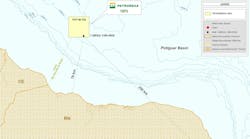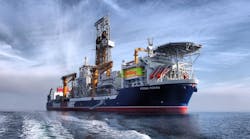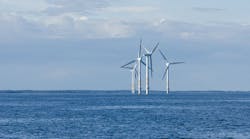Offshore lifting operations bring the risk of accidents and damage to materials and equipment. To reduce this risk, lifts normally proceed only when weather and sea conditions are clear and smooth: this can impact greatly on efficiency and cost.
Specialist offshore crane and lifting equipment manufacturer Huisman-Itrec, based in Rotterdam, has introduced several new systems over the years to improve safety and minimise downtime, including one of the first active heave compensation systems in 1985. In 1992, advances in electronics, sensor technology, and improved secondary hydraulic drive systems allowed it to develop real time active heave compensation, which permits more precise lifts in more severe weather.
Theory
A crane mounted on a vessel undergoes motion due to heave, roll, pitch, surge, sway, and yaw. The first three motions chiefly cause a significant disturbance of the lower block's vertical position.
The aim of heave compensation is to substantially reduce this heave motion of the lower block. Ideally, the lower block would remain in a fixed position relative to the seabed.
In an active heave compensation system the heave speed of the lower block caused by the heave, roll and pitch motions of the vessel are compensated by controlling the speed of the winch.
By paying out or hauling in the wirerope with a rope speed equal but opposite to the crane tip's vertical displacement, a significant discoupling of the motions of the lower block and the vessel can be achieved whereby normal joystick control is still possible.
An active heave compensation system can be divided roughly into three main parts: the sensor unit, control unit and drive system. Errors in the value of the actual heave, roll and pitch are propagated throughout the heave compensation system into the position of the lower block. Therefore, the motion reference unit has to be a high quality measuring device. The introduction to the market of several very sensitive, gravity based solid state motion reference units has been a major improvement in the development of accurate active compensation systems.
To exert full control over all system parameters, Huisman-Itrec has developed a digital control system. Development was focused on selection of hardware which could ensure reliable operation and PC compatibility for easy maintenance. The software is designed so that fault tolerance and detection is carefully integrated to ensure maximum safety.
The digital control system is typically designed as a servo control loop. The setpoint of this loop is calculated from actual data concerning the heave, roll and pitch of the vessel. Feedback of the actual paid out rope length eliminates long-term drift in the control loop.
To ensure accuracy of the heave compensation, a fast response of the winch motors should be combined with the capability to handle momentary peaks in the power consumption. These two features are combined in secondary controlled hydraulic drives.
Essentially, speed control of the motor axis is achieved by feedback of the actual motor speed which is measured by means of a tacho generator. The controller directly controls the swashplate angle and thus the torque exerted by the motor axis on the winch. To keep the actual speed of the motor axis equal to the setpoint value, the controller will constantly adjust the swashplate angle.
Another advantage of secondary control is energy recovery capability. When a load is lowered, the flow in the motor is reversed and the energy is recovered. This energy is stored by means of an hydraulic accumulator, for later use to equalise peaks in power consumption.
Offshore trials
Several offshore trials have been carried out with the new active heave compensation system on an OMC 5600 crane on board the semisubmersible MSV Amethyst. For test purposes, this 300 ton Huisman crane has been equipped with an active heave compensation system on both the main hoist and auxiliary hoist. Tests were caried out in the northern part of the North Sea, under seastate 3-4 conditions.
To achieve an independent indication of the vertical motion of the ship, the auxiliary hoist was put in the constant tension mode. Here the tension in the rope connected to a load on the seabed is kept at a constant pre-set value. The paid out rope is an absolute indication of the vertical motion of the crane tip. The main hoist was controlled by the heave compensation system.
In January last year, Huisman-Itrec delivered an active heave compensated, three-drum ROV winch for handling of the new stonedumping ROV Stonewatcher for Tideway/Dredging International. The fall pipe handling systems as well as the ROV were also manufactured by Huisman-Itrec. During offshore trials, the heave compensation system proved very satisfactory. Currently the Rollingstone stone dumper is working with great precision, using this system.
Future applications which the company is working on include the case of a crane mounted on a fixed platform, where heave compensation can be used to keep the lower block of the crane in a steady position relative to the supplier. This should facilitate the loading and unloading of suppliers considerably. As a result, risk of damage to materials and equipment should decrease significantly.
To achieve this, a portable motion sensor with a built-in fast telemetry transmitter is placed on the supply vessel. This unit transmits the motion data to the control system of the platform crane which can then be put into active heave compensation mode.
Copyright 1995 Offshore. All Rights Reserved.




